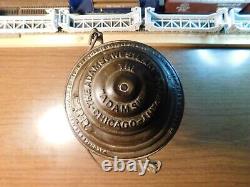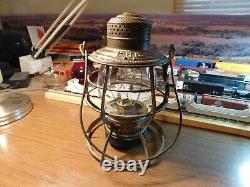Pennsylvania Railroad Lantern Adams & Westlake Company P. R. R. Theadams 1886


















This Vintage piece of Railroad History, made by THE ADAMS AND WESTLAKE COMPANY for the PENNSYLVANIA RAILROAD. This lantern is marked THE ADAMS AND WESTLAKE COMPANY CHICAGO THE "ADAMS" P. Patented JUNE 8, 1886, last date NOV. The brass burner and twist off f uel fount show sign of aging, no pin holes.
The Corning clear glass globe is embossed P. Cnx F has NO CRACKS some small chips around rims. From Wikipedia, the free encyclopedia. For the prison system known as the Pennsylvania System, see separate system.
Map of Pennsylvania Railroad up to 1945. April 13, 1846-January 31, 1968 renamed to Penn Central Transportation Company.
12.5 kV 25 Hz AC. 11,640.66 miles (18,733.83 kilometers) (1926). The Pennsylvania Railroad reporting mark. PRR , legal name The Pennsylvania Railroad Company, also known as the " Pennsy ", was an American Class I railroad.
That was established in 1846 and headquartered in Philadelphia. It was named for the commonwealth in which it was established. At its peak in 1882, the Pennsylvania Railroad was the largest railroad (by traffic and revenue), the largest transportation enterprise, and the largest corporation in the world. Over its existence, Pennsylvania Railroad acquired, merged with, or owned part of at least 800 other rail lines and companies.
At the end of 1926, it operated 11,640.66 miles (18,733.83 kilometers) of rail line. In the 1920s, it carried nearly three times the traffic as other railroads of comparable length, such as the Union Pacific. And Atchison, Topeka & Santa Fe.
Its only formidable rival was the New York Central Railroad. (NYC), which carried around three-quarters of the Pennsy's ton-miles.In 1968, the Pennsylvania Railroad merged with New York Central and the railroad eventually went by the name of Penn Central Transportation Company. Or "Penn Central" for short. The former competitors' networks integrated poorly with each other, and the railroad filed for bankruptcy within two years.
Bankruptcy continued and on April 1, 1976, the railroad gave up its railroad assets, along with the assets of several other failing northeastern railroads, to a new railroad named Consolidated Rail Corporation. With Norfolk Southern getting 58 percent of the system, including nearly all of the remaining former Pennsylvania Railroad trackage. Received the electrified segment of the Main Line. And is now a subsidiary of American Financial Group. 1857 map of the Pennsylvania Railroad system.
With the opening of the Erie Canal. In 1825 and the beginnings of the Chesapeake and Ohio Canal. In 1828, Philadelphia business interests became concerned that the port of Philadelphia would lose traffic. The state legislature was pressed to build a canal across Pennsylvania and thus the Main Line of Public Works.
It soon became evident that a single canal would not be practical and a series of railroads, inclined planes, and canals was proposed. The route consisted of the Philadelphia and Columbia Railroad. Canals up the Susquehanna and Juniata rivers, an inclined plane railroad. Called the Allegheny Portage Railroad. A tunnel across the Allegheny Mountains.
And canals down the Conemaugh and Allegheny rivers to Pittsburgh, Pennsylvania. On the Ohio River; it was completed in 1834. There were two applications made to the Pennsylvania legislature in 1846. The first was for a new railroad called The Pennsylvania Railroad Company to build a line between Harrisburg. The second was the Baltimore and Ohio Railroad.
(B&O), which wanted to build to Pittsburgh from Cumberland, Maryland. Both applications were granted with conditions. If the Pennsylvania Railroad did not raise enough capital and contract to build enough railroad within a year, then the B&O bill would become effective and the Pennsy's void, thereby allowing the B&O to build into Pennsylvania and on to Pittsburgh.
The Pennsylvania Railroad fulfilled the requirements and Letters Patent. Were issued by the Pennsylvania governor on February 25, 1847. The governor declared the B&O's rights void the following August.


